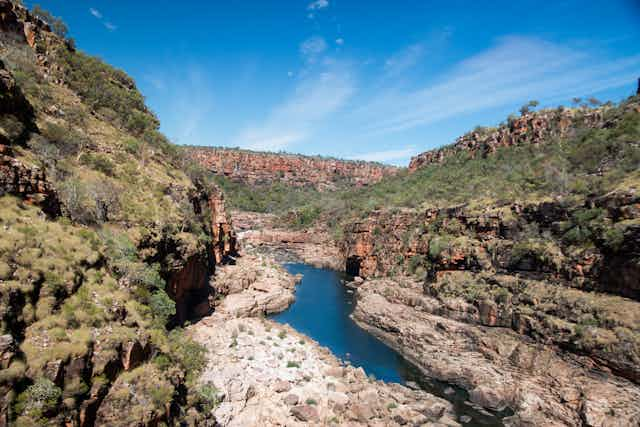We recently discovered 20 new species of fish in the Kimberley region of north-west Australia (one of them has been named after writer Tim Winton).
But that’s only the start of the story. At a time when the federal government is redoubling efforts to develop northern Australia, our discovery is a timely reminder of how little we know about our country.
A 2014 CSIRO report found 1.4 million hectares of land in northern Australia could be irrigated. Underlying this expansion would be approximately 90 large dams and numerous smaller water-regulating structures such as weirs.
While this could boost the northern Australian economy, impacts on aquatic ecosystems from altered flow regimes, habitat modification and reduced water quality are likely to be significant.

Threatened waterways
Fish are the most researched group of species living in Australia’s freshwater ecosystems. As such, we can use them as indicators of how much we know about these environments.
To date, research effort has been focused on south-east Australia. What stands out is a lack of research across much of the country, particularly in the north.
Despite this, northern Australia’s freshwater fish fauna is very diverse and includes many fish found across tiny areas. Unfortunately the lack of research means that for many of northern Australia’s fishes, all we know is that they exist.
Under the federal Environment Protection and Biodiversity Conservation (EPBC) Act, 16% of Australia’s freshwater fish are listed as threatened. But most of the species analysed are from the rivers of south-east Australia, which are most affected by people.
In a recent study we identified another 55 potentially vulnerable species that meet the criteria for conservation listing.
When we mapped the already listed and potentially vulnerable fish species, we found hotspots for fish conservation in the Kimberley, the Wet Tropics and Arnhem Land.

While often overlooked, Australia’s freshwater fish are almost as unique as our kangaroos and koalas: 74% of these fish are found nowhere else in the world.
If enigmatic northern Australian species, such as the saratoga (Scleropages leichardti), the long-nosed sooty grunter (Hephaestus epirrhinos) or the Prince Regent gudgeon (Hypseleotris regalis) are lost, we contribute to an ongoing global freshwater fish extinction crisis. Australia’s freshwater fish deserve adequate protection.
Exploring the north
The Kimberley in northern Western Australia is rugged, remote, pristine and holds a number of species found nowhere else. We decided to investigate the region’s freshwater fishes.
Before our project began, we knew that the region was home to 50 species of freshwater fish, or almost a quarter of Australia’s freshwater fish species. Eighteen of these are found only in the Kimberley region.
Over the past three years, we spent nine months surveying over 70 sites on 17 of the Kimberley’s rivers. We found that many of the endemic species are potentially particularly vulnerable if their environment were to change. For example, the long-nosed sooty grunter is large, found in a single river, rare and exclusively carnivorous, making it vulnerable to extinction.
Excitingly, we also uncovered 20 new species of freshwater fish. This increases the known freshwater fish species in Australia by roughly 10% and, with 70 species in total, it makes the Kimberley the most diverse region for freshwater fish.
Many of the new species are large, clearly distinct fish, which could be identified as new species when we observed them from the riverbank. We found most of these new species in rivers we could only access by helicopter.
Put simply, due to the difficultly and expense of sampling the remote Kimberley wilderness, we just haven’t looked hard enough in the region’s rivers. Entire river systems in the Kimberley remain unsampled and we should not be surprised to uncover more species unknown to science.
What else is out there?
Our findings raise questions about the environmental sustainability of developing northern Australia. If we can find 20 new species of freshwater fish in nine months of fieldwork in the Kimberley, how many more species are present across the rest of northern Australia?
Fish are big and easy to find compared to most of the smaller aquatic life. They represent the conspicuous tip of the iceberg of what lives in our rivers. What happens if we investigate more cryptic or poorly known taxa such as amphibians or invertebrates?

How can we manage and protect species we don’t know exist? Before we develop the north, we need to know what’s out there.
The majority of northern rivers remain in relatively good condition, so there is ample opportunity to ensure that species are not lost as a result of development. Fortunately, most major developments are a decade or more away, so there is time to gather this information.
Learning from the south
Many rivers in southern Australia have been degraded by habitat modification, altered flow patterns, invasive species, barriers to fish movement, reduced water quality and overexploitation.
Many fish species are threatened. Of 46 species found in the Murray-Darling Basin, 19 are listed as threatened at the state or national level.
What have we learned?
River flow, infrastructure and land use all need to be actively managed to maintain healthy rivers and allow key ecological processes, such as migrations and the inundation of floodplains, to continue. We need to be vigilant to prevent alien species invading.
A major source of conflict in the Murray-Darling Basin Plan was the allocation of water to the environment. Considering the environment as a stakeholder at the beginning of this process could have avoided future conflicts.
These practices will need to be adapted to the highly seasonal rainfall of northern Australia, which will be challenging. Intact rivers with particularly high numbers of species found nowhere else may be good candidates for freshwater protected areas, which are rare in Australia.
We need to ensure that our unique freshwater fishes are properly conserved. With research and good planning, we can ensure we do not repeat the sins of the past in northern Australia.

